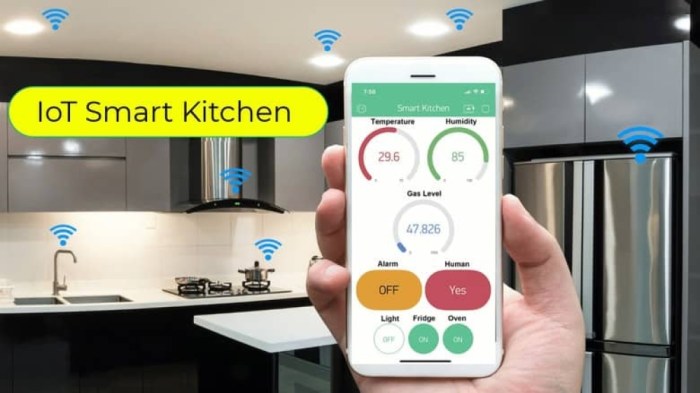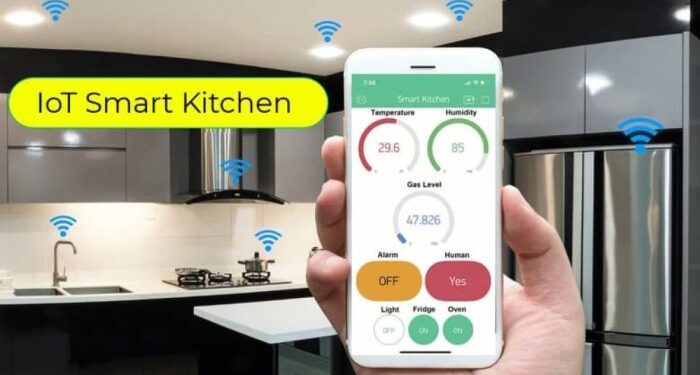Embark on a journey into the future of culinary innovation with Smart kitchen design with IoT integration. Discover how technology is reshaping the way we interact with our kitchen appliances, creating a seamless and efficient cooking experience like never before.
Explore the endless possibilities of integrating IoT into kitchen design and how it can elevate your everyday cooking routine to new heights of convenience and functionality.
Understanding Smart Kitchen Design

Smart kitchen design refers to the incorporation of technology and innovation into the layout and functionality of a kitchen space. This involves utilizing modern appliances, gadgets, and systems to enhance efficiency, convenience, and safety in the kitchen environment.The concept of integrating IoT (Internet of Things) into kitchen design involves connecting various appliances and devices to the internet, enabling them to communicate with each other and be controlled remotely.
This connectivity allows for automation, monitoring, and customization of kitchen functions, making daily tasks easier and more streamlined.
Examples of IoT devices commonly used in smart kitchens:
- Smart Refrigerators: These refrigerators are equipped with features such as cameras, touchscreens, and Wi-Fi connectivity, allowing users to view contents, create shopping lists, and adjust settings remotely.
- Smart Ovens: IoT-enabled ovens can be controlled via smartphone apps, offering features like preheating, temperature adjustment, and recipe suggestions for optimal cooking results.
- Smart Coffee Makers: These devices can be programmed to brew coffee at specific times, adjust brew strength, and even reorder coffee beans automatically when running low.
- Smart Lighting Systems: IoT-connected lights can be controlled through voice commands or mobile apps, allowing users to adjust brightness, color, and scheduling for energy efficiency and ambiance.
Benefits of IoT Integration in Kitchen Design
IoT integration in kitchen design offers a range of benefits that enhance convenience, efficiency, and energy savings.
Enhanced Convenience
- Remote Access: IoT-enabled kitchen appliances allow users to control and monitor them remotely through smartphone apps or voice assistants, providing convenience and flexibility.
- Automated Functions: IoT integration enables automation of tasks such as preheating the oven, brewing coffee, or adjusting the refrigerator temperature, saving time and effort.
- Personalized Settings: Smart kitchen devices can learn user preferences over time and adjust settings accordingly, providing a personalized cooking experience.
Improved Efficiency
- Optimized Resource Management: IoT technology helps in optimizing resource usage by monitoring and adjusting water, electricity, and gas consumption based on real-time needs, leading to cost savings.
- Inventory Management: Smart refrigerators equipped with IoT sensors can track food inventory, expiry dates, and suggest recipes based on available ingredients, reducing food waste.
- Enhanced Cooking Precision: IoT-enabled appliances offer precise temperature control, cooking times, and ingredient measurements, ensuring consistent and high-quality results every time.
Energy Efficiency
- Energy Monitoring: IoT devices can monitor energy consumption of kitchen appliances and provide insights to help users make informed decisions to reduce energy usage and lower utility bills.
- Smart Scheduling: Automated scheduling of appliance usage during off-peak hours can help in optimizing energy efficiency and reducing overall energy costs.
- Adaptive Controls: IoT integration allows appliances to adapt to energy-saving modes based on usage patterns, contributing to a more sustainable and eco-friendly kitchen environment.
Key Features of Smart Kitchen Appliances
Smart kitchen appliances are revolutionizing the way we cook and interact with our kitchen space. These appliances are equipped with advanced technology to make cooking more convenient, efficient, and enjoyable. Let's explore some key features of smart kitchen appliances.
Smart Refrigerators
Smart refrigerators come with features like built-in cameras that allow you to see the contents of your fridge from anywhere using your smartphone. They also have touchscreens for creating shopping lists, setting reminders, and accessing recipes. Some models even have voice control capabilities, so you can ask your fridge to add items to your shopping list or adjust the temperature.
Smart Ovens
Smart ovens offer features such as Wi-Fi connectivity, allowing you to preheat your oven remotely or receive notifications when your food is ready. They also come with cooking presets for different types of dishes, ensuring perfect results every time. Some models have built-in cameras that let you monitor your food as it cooks, ensuring it is cooked to perfection.
Voice Assistants in Smart Kitchen Devices
Voice assistants like Amazon Alexa or Google Assistant play a crucial role in controlling smart kitchen devices. They allow you to operate your appliances hands-free, simply by using voice commands. For example, you can ask your voice assistant to preheat the oven, set a timer, or even find a recipe for you while you're cooking
This hands-free operation adds a new level of convenience to your kitchen experience.
IoT Connectivity and Data Security
In a smart kitchen with IoT integration, devices like refrigerators, ovens, and coffee makers communicate with each other through a wireless network. This allows them to share information, coordinate tasks, and provide a seamless cooking experience for users.
Importance of Data Security and Privacy
Ensuring the security and privacy of data in IoT-integrated kitchens is crucial to protect sensitive information and prevent unauthorized access. Here are some key considerations:
- Use strong, unique passwords for each IoT device to minimize the risk of hacking.
- Regularly update the firmware of IoT devices to patch any security vulnerabilities.
- Enable encryption on your wireless network to secure data transmissions between devices.
- Monitor your network for any unusual activity that could indicate a security breach.
Tips to Secure IoT Devices
Securing your IoT devices is essential to safeguard your personal information and maintain the integrity of your smart kitchen. Here are some tips to enhance the security of your devices:
- Change default login credentials on all IoT devices to unique, strong passwords.
- Disable any unnecessary features on IoT devices that could pose a security risk.
- Keep all IoT devices updated with the latest security patches and firmware releases.
- Implement network segmentation to isolate IoT devices from other connected devices in your home network.
Designing a Functional Smart Kitchen Layout
When designing a smart kitchen layout, it is essential to consider the placement of IoT devices to ensure optimal functionality and accessibility. Organizing a smart kitchen efficiently can help maximize the benefits of IoT integration and enhance the overall cooking experience.
Placement of IoT Devices
- Place smart appliances strategically for easy access and usability. For example, install smart refrigerators near food preparation areas for quick and convenient ingredient retrieval.
- Consider the workflow in the kitchen and position IoT devices accordingly. Place smart ovens and cooktops close to each other to streamline the cooking process.
- Ensure that IoT devices are placed within reach but away from water sources to prevent damage. Smart faucets and sinks should be installed in convenient locations for efficient meal preparation and cleanup.
Organizing for Efficiency
- Utilize smart storage solutions to keep kitchen essentials organized and easily accessible. Smart cabinets with sensor-activated lights and automated shelving can help optimize storage space.
- Implement a central control system for IoT devices to simplify operation and monitoring. A smart hub or voice-activated assistant can facilitate seamless communication between different appliances.
- Create designated zones for specific tasks, such as cooking, food storage, and meal planning. This division can help streamline workflow and increase productivity in the kitchen.
Outcome Summary
As we conclude this exploration of Smart kitchen design with IoT integration, it's clear that the future of cooking is smart, connected, and brimming with exciting possibilities. Embrace the technological evolution in your kitchen and unlock a world of culinary creativity at your fingertips.
FAQ Overview
How can IoT devices enhance energy efficiency in the kitchen?
IoT devices can optimize energy consumption by automating processes like turning off appliances when not in use or adjusting settings based on usage patterns.
What are some essential features of smart kitchen appliances?
Smart kitchen appliances often include features like remote control capabilities, energy monitoring, and integration with voice assistants for hands-free operation.
How do IoT devices communicate with each other in a smart kitchen?
IoT devices in a smart kitchen typically communicate through wireless networks like Wi-Fi or Bluetooth, enabling seamless connectivity and data sharing.



